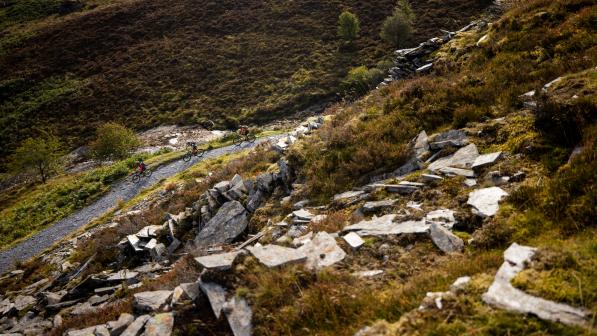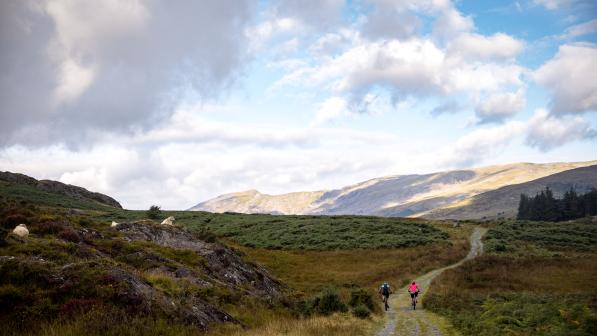Great rides: Traws Eryri

Fighting for breath, I concentrated on keeping my pedals moving over the rocky terrain, trying to maintain enough momentum to keep the front wheel in a vaguely straight line. I could see the bright daylight breaking through the trees ahead of me at the top of the climb. Just a little bit further…
To my relief, the climb eased as I emerged from the forest, and I paused to take in the view. Across the valley to my left were the Rhinogydd hills. The shining expanse of Llyn Trawsfynydd reservoir lay below me, with its hulking decommissioned nuclear power station looking out of place on the far side.
Ahead, the gravel track of the Sarn Helen Roman road curved around the hillside, leading down towards the water. Not far to go now. One more photo, then I let my wheels start rolling downwards to enjoy the swooping descent into the valley.
That was one of those days on a cycling trip where by the time you reach your overnight stop, the morning feels a world away. We might have ridden fewer than 40 miles but the steep climbs, challenging terrain and contrasting landscapes made it feel like we’d travelled much further.
Five of us were test riding the Traws Eryri (Trans Snowdonia) trail, created by Cycling UK in partnership with Natural Resources Wales and launching at the end of August. Starting in Machynlleth, the trail wiggles its way through the spectacular mountains and forests of North Wales to finish at the sea beside Conwy Castle.
While most of the route uses existing bridleways, forest tracks and cycle paths, a few sections required negotiating permissive access with landowners to be able to ride through amazing areas that would otherwise be unavailable to bikes.

Cadair Idris and Coed Y Brenin
We’d started the day in Machynlleth, at the southern end of Eryri (Snowdonia) National Park. A fairly gentle first few miles meandering beside the river eased us in for a steep zig-zag climb up into the forest. Then we were out into the open and it felt like the adventure had properly begun, as we headed through the hills on undulating gravel tracks skirting around the western bulk of Cadair Idris.
Rounding a corner, we could see the sands of the Mawddach Estuary laid out below us. We dropped down to the beauty spot of Cregennan Lakes, where we encountered the first other people we had seen that day.
After looking down from high above, we were now gliding along the Mawddach Estuary Trail, smiling at kids wobbling along the path. The tide was low, and we lingered taking photos of the swirly patterns of silver water on sand. Eventually our rumbling stomachs prompted us to press on to Penmaenpool, where Phill from MTB Cymru was waiting with our lunch by the historic toll bridge.
Normally I’m a bit of a purist about cycle trips: I like to know that I’m carrying all the gear I need – a tortoise with my house on the back. For this one I’ll admit I appreciated being supported by Phill.
I’ve done several off-road trips but I’m not the most confident mountain biker, and being able to tackle the steep climbs and some of the more rocky descents without a fully loaded bike made a huge difference. With our guide Polly leading the way, we knew we were in safe hands.
It was a good job we had refuelled, as immediately afterwards we were faced with a punishingly steep climb on a tiny lane up Cwm Mynach, which translates as Valley of the Monks (although we didn’t spot a monastery). Polly’s local knowledge came in handy for a few short detours to incorporate some of the mountain bike trails at Coed y Brenin.
This sparked some discussion about the different ways of riding Traws Eryri. At one end of the scale, you could do it as a fully loaded bikepacking trip, sticking to the main route along the forest tracks. At the other end, you could ride it supported and spend some more time exploring the more technical trails at the various trail centres along the route. I found myself wanting to try it both ways, for two entirely different experiences.
Starting in Machynlleth, the trail wiggles through the spectacular mountains and forests of North Wales
Ice creams in Betws-Y-Coed
That second morning, Eryri blessed us with crisp September sunshine and ever-changing patterns of light and shade on the hills as we climbed a lane curving up the valley, taking frequent opportunities for a breather to turn back and admire the view. The bit we couldn’t see, hiding behind the hill to our left, was Manod Quarry.
During WW2, the underground chambers of the quarry acted as a repository for the National Gallery, with priceless artworks evacuated from London and hidden deep in the mines, safe from German bombs, a secret arrangement that continued into the Cold War.
The Llwybr Llechi Eryri (Snowdonia Slate Trail) walking route passes through the old quarry, and Cycling UK is in discussions about potential landowner permissions for the Traws Eryri trail to follow the same line. Riding through here would be an incredibly atmospheric way to appreciate the impact that slate mining has had on the landscape of this area.
For now, though, we skirted around the quarry on the road to reach Penmachno.
No time for a rest on the other side: we had to push on up another bottom-gear climb into the forest. We were aiming for lunch in Betws-y-Coed, which didn’t look far, but the constant ups and downs of the forest tracks made progress slower than expected. We were relieved when Phill appeared to meet us (along with trail dog Suki), saying we didn’t have to make it that far as he had sandwiches for us around the corner.
Finally, we made it to Betws-y-Coed for a mid-afternoon ice cream. The square bustling with people was a bit of a shock, having seen almost no one all day. We were staying just a few miles away in Capel Curig but the straight-line option would have been too easy. We had another climb waiting for us, up through Gwydir Forest.
The forest was fairly open in places, revealing stunning views of the surrounding mountains. We were rewarded with a long descent into Capel Curig, as the afternoon light turned golden around us.
When we reached the bottom, there was one thing left to do: a quick swim in the lake to soothe tired muscles. It was one of the most scenic places I’ve ever swum, looking out across the lake to the Yr Wyddfa (Snowdon) horseshoe as the sunlight glimmered across the water.

Bethesda, Bangor and a Roman non-road
The final day was into more familiar territory for me, as I’d ridden part of it on a previous trip, but it still took my breath away. The constantly changing light patterns playing across the formidable steep mountainsides of Tryfan and the Glyderau to the left and the Carneddau soaring away to the right were stunning.
Gliding further down the valley, the mountains became man-made: towering piles of slate surrounded us as we zig-zagged through the Penrhyn slate quarries at Bethesda. It was a visceral reminder of just how big the industry was in this area. These slate quarries were the largest in the world at the end of the 19th century, and now form part of the Slate Landscape of Northwest Wales World Heritage Site.
Our gentle descent ended abruptly as we approached the coast near Bangor, and then turned inland to give the legs a rude awakening with a steep road climb. A tree-lined stream valley opened out to become a wide gravel track contouring along an open hillside, with amazing views out towards the North Sea and Ynys Môn (Anglesey).
If you looked beneath the incongruous line of pylons, this track had a timeless feel to it. It used to be a Roman road. However, despite being travelled by people for millennia, this route is bizarrely not a public right of way. Cutting across land which has open access rights for walking, it’s the kind of route which you logically ought to be able to cycle on.
The Welsh Government has recognised that, and made a commitment in 2019 following Cycling UK’s Trails for Wales campaign that it would make changes to enable people to explore the countryside more easily – including allowing cycling on existing tracks and paths across open access land, such as this one.
Unfortunately, that commitment has not yet translated into change on the ground, and it proved difficult to identify who owned this area of land to try and secure permissive access to include the Roman road on the route. For now, we’ve had to leave out this short section and use the coastal cycle path instead.

Access conundrum near Conwy
The Roman road turned into a beautiful descent down the hillside, straight towards the sea. We felt triumphant as we approached the coastline and the finish. Our excitement was premature. The route swung right as we turned inland once again. Conwy Mountain stood between us and the end. One last big climb then…
It was breathtaking in all senses of the word. We made our way through a landscape woven with legends, full of stone circles and burial mounds.
The trail we were following also had a somewhat mythical character to it, becoming fainter until we could no longer see where it went. Ride leader Polly checked the map, frowning in confusion. “This must be the way,” she said. “It shows the byway going straight ahead, and that track to the right is the footpath.”
A conundrum: a hike-a-bike section following an invisible path through boggy heather, or a rideable, well-surfaced path where we would have much less impact on the ground, but which didn't technically have access for cycling?
We opted to stick with the non-existent byway, hoping that it would emerge at some point. It didn’t – we just got wet feet. Information about who owned this land proved equally elusive, so we haven’t been able to ask permission to use the footpath for Traws Eryri and for now have to direct cyclists along the soggy byway.
Tricky bit negotiated, this time it really was the final stretch, swooping past the dramatic Sychnant Pass and down into Conwy. A curve around the estuary cycle path, and suddenly the majestic sight of Conwy Castle came into view to mark the end of our journey.
It had been a spectacular few days of journeying through epic mountain landscapes. With several thousand metres of climbing in the legs, we were ready for a rest, if reluctant to leave it all behind.
It’s not the end of the story, however. Traws Eryri is a beautiful route, but a few small changes could make it even more memorable. Cycling UK will continue working to improve it – in the short term, by hopefully agreeing those elusive permissive sections, and in the long term, by campaigning for access reform to be implemented. I’m excited to see it develop.








